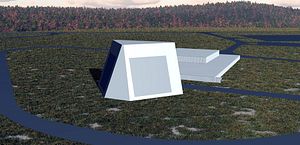Earlier this month, reports citing sources within the Japanese Ministry of Defense indicated that Japan’s deployment of the Aegis Ashore missile defense system will be built around a variant of Lockheed Martin’s still-in-development Long Range Discrimination Radar (LRDR), instead of the Raytheon SPY-6 radar. While details of the precise LRDR variant Japan will use are unknown, it is likely that the radar will feature reduced range. In any case, the full-fledged LRDR, as described by Lt. Gen. Samuel A. Greaves, the director of the U.S. Missile Defense Agency, in testimony earlier this year is a “midcourse sensor that will provide persistent long-range midcourse discrimination, precision tracking, and hit assessment and improve BMDS target discrimination capability while supporting a more efficient utilization of the GMD interceptor inventory.”
Setting aside the suitability of LRDR for Japan’s midcourse interception needs for a moment, it bears interrogating whether the selection of LRDR might emerge as a new thorn in Sino-Japanese relations. As I explained last year, China’s over-the-top reaction by U.S. Forces Korea to deploy a Terminal High Altitude Area Defense battery in South Korea had to do primarily with the the advanced, high resolution AN/TPY-2 radar accompanying the launchers—not the launchers themselves. Similarly, even if the LRDR variant deployed by Japan is drastically different from the GMD-supporting primary version in development for the United States, it’s far from clear that China will let that pass. (Beijing declined U.S. invitations for technical talks over THAAD in 2016.)
The idea behind Chinese opposition to advanced missile defense sensors in Northeast Asia is simple: China fears that U.S. efforts to establish theater-wide missile defense sensors could erode the efficacy of the country’s relatively lean strategic deterrent. In specific terms, Beijing was concerned that the United States could operate the AN/TPY-2 radar, now located in South Korea’s Seongju county, in forward-based mode. The United States, meanwhile, has claimed that the radar will operate exclusively in terminal mode, which allows the THAAD system to serve a defensive role against prospective ballistic missile threats from North Korea.
Not only is LRDR being designed with support for the United States’ Ground-Based Midcourse Defense (GMD) system in mind, the U.S. National Security Strategy (NSS) published earlier this year emphasized U.S. intentions to “cooperate on missile defense with Japan and South Korea to move toward an area defense capability.” That’s not the same thing as homeland missile defense, but, along with a prospective LRDR deployment in Japan, Beijing will have reason for concern. (The NSS does also note that “enhanced missile defense is not intended to undermine strategic stability or disrupt longstanding strategic relationships with Russia or China,” though the administration’s upcoming Missile Defense Review may tweak that view.) Should Tokyo give Beijing assurances that its LRDR will be discrete from the U.S. homeland missile defense sensor networks, it’s unlikely that China would take this for granted—China cast aside similar assurances on the AN/TPY-2 deployed in South Korea.
For the moment, China has not chosen to treat reports of Japan’s selection of LRDR in the same way that it dealt with the THAAD deployment in South Korea. Part of the reason for this might be that the Japanese Ministry of Defense has yet to confirm the decision on-the-record, or, more realistically, that Japan’s deployment of Aegis Ashore remains years away in 2023. Tokyo and Beijing are currently undergoing a broader diplomatic thaw anyway and it may not be in China’s interest to rock the boat over a deployment that is far from proximate. Either way, the few Chinese official statements that have addressed the Japanese Aegis Ashore deployment decision have been careful not to overtly condemn Tokyo.
Last August, following U.S.-Japan military-to-military talks on Aegis Ashore deployment acceleration, the Chinese Ministry of Foreign Affairs issued a cautionary note, but stopped short of condemning Japan. “The Chinese government always maintains that the missile defense issue should be handled cautiously as it bears on global strategic stability and the mutual trust between major countries,” spokesperson Hua Chunying added at the time.
“While taking into account their own security interests, all relevant parties should respect the legitimate security concerns of other countries, jointly follow the principles of upholding global strategic stability and undiminished security for all countries and safeguard the international security environment featuring peace, stability, equality, mutual trust, cooperation and win-win outcomes,” she added.
In December, when Japan’s decision to select Aegis Ashore over THAAD was announcement, Hua was more pointed in her criticism, tying Tokyo’s procurement decision to historical tensions in East Asia. “Due to what happened in history, Japan’s moves in the fields of military and security are always followed closely by its Asian neighbors and the international community.” She continued: “When it comes to the anti-missile issue, the Chinese government always believes that it bears on the global strategic stability and the mutual trust between countries.
It bears noting, however, that we have yet to see anything from China coming close to the high-level critical rhetoric that South Korea saw when in exploratory talks over the deployment of THAAD on its territory. As the United States and South Korea debated the merits of deployment, none other than Chinese Foreign Minister Wang Yi felt it necessary, as early as February 2016, to emphasize that “the monitoring scope of [THAAD’s AN/TPY-2] X-Band radar, goes far beyond the defense need of the Korean Peninsula.” The official Chinese reaction was specific.
Tokyo may find itself facing similar Chinese concerns as 2023 approaches and more specifics emerge about its Aegis Ashore deployment plans. In the meantime, China is no doubt going to keep a close eye on Japan’s choices and evolving U.S.-Japan cooperation on ballistic missile defense.
































